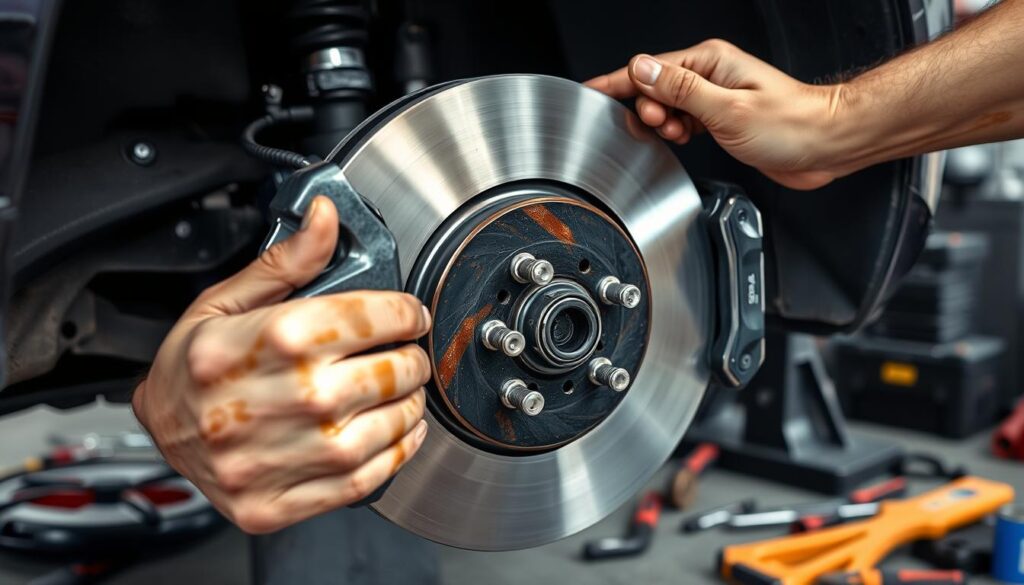As a car owner, you know how vital it is to keep your vehicle in great shape. But brake maintenance is more than just car care. It’s about keeping you and others safe. Imagine if your brakes failed when you needed them most. Or if you worried about their safety on long trips.
That’s why brake care is so important. It’s a duty we all have as drivers. We must ensure our brakes are ready for anything.
In this guide, we’ll cover the key steps for brake upkeep. You’ll learn about brake parts and how to spot wear. We aim to give you the skills to handle brake tasks, whether you DIY or prefer a pro.
This article will be your guide to safer, more reliable brakes. Stay safe and confident on the road.
In This Guide
Understanding Your Vehicle’s Brake System Components
Knowing your car’s brake system is key for safety and performance. Your brakes are crucial for a safe drive. Let’s look at the main parts that help your car stop smoothly.
Types of Brake Systems
Cars have either disc brakes or drum brakes. Disc brake pads press on the rotor. Drum brake shoes push against the drum. Many cars use both, with discs in the front and drums in the back.
Key Brake Parts and Their Functions
- Brake pads: They create friction to slow your car.
- Brake rotors (or discs): The metal discs the pads grip to slow the wheels.
- Brake calipers: They hold the brake pads and press on the rotors when you brake.
- Brake shoes: In drum brakes, they press against the drum to slow the wheels.
- Brake caliper overhaul: Regular checks and services keep the calipers working right.
Warning Signs of Brake Problems
Watch for changes in how your brakes work. They might show a problem. Look out for:
- Squeaking or grinding noises when you brake.
- A soft or spongy brake pedal.
- The car pulling to one side when braking.
- It takes longer to stop.
Fixing these issues early can avoid bigger, more expensive problems later.
The Importance of Regular Brake Maintenance
Keeping your vehicle’s brake system in good shape is key for safe driving. Regular brake system inspections offer many benefits. They help you avoid expensive repairs and keep your brakes working well for longer.
One big reason for brake maintenance is to make your brakes work better. By checking for brake pad wear indicators and other signs of wear, you can spot problems early. This way, you can fix them before they get worse. This keeps your brakes working well, which is important for your safety and others on the road.
Regular brake system inspections also make your brake parts last longer. This includes pads, rotors, and calipers. By finding problems early, you can avoid having to replace them too soon. This saves you money over time.
Also, brake maintenance helps find any hidden issues with your brakes. Catching problems like fluid leaks or uneven pad wear early means you can fix them quickly. This stops more damage and keeps your brakes safe.
Spending on regular brake system inspections is worth it for the peace of mind and safety it brings. By keeping up with your vehicle’s maintenance, you make sure your brakes are always ready to go.
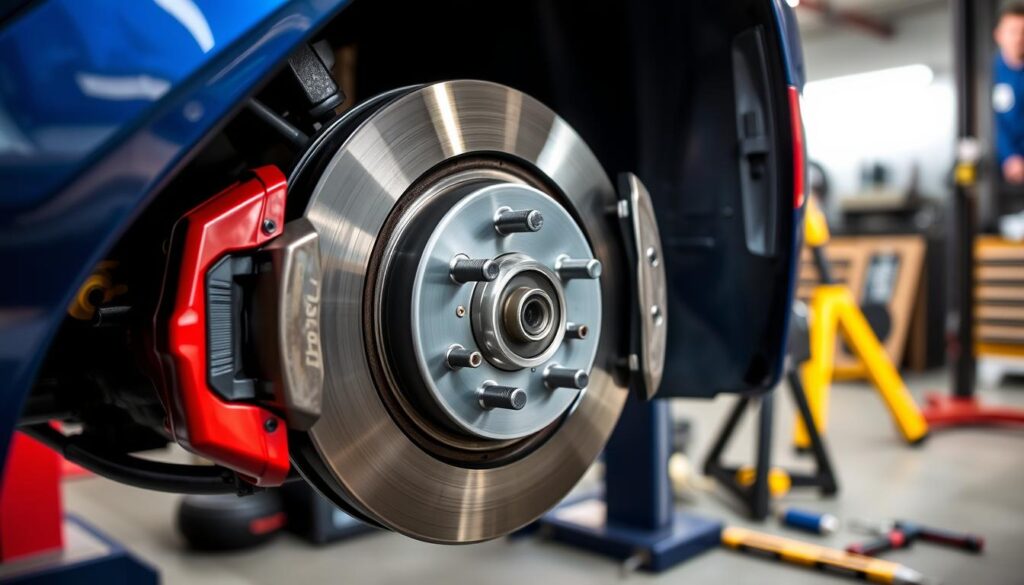
“Proper brake maintenance is essential for ensuring the safety and longevity of your vehicle’s braking system.”
When to Replace Your Brake Pads and Rotors
Keeping your car’s brakes in top shape is key to your safety. Knowing when to swap out brake pads and rotors can prevent problems. It keeps your car’s brakes working well.
Signs of Worn Brake Pads
A high-pitched squeal or grinding sound when braking means your pads need a change. This noise happens when the pads touch the rotor. Also, if your car takes longer to stop, it’s a sign of worn pads.
Rotor Wear Patterns and Damage
It’s important to check your brake rotors often. Look for uneven wear, like grooves or “hot spots.” If rotors are severely warped or cracked, replace them right away for safe braking.
Professional vs. DIY Replacement
Some people try to replace brake pads and rotors themselves. But, it’s usually better to let a pro do it. They have the right tools and know-how to do it right. Brake rotor resurfacing and brake pad wear indicators are best left to the experts for top brake performance.
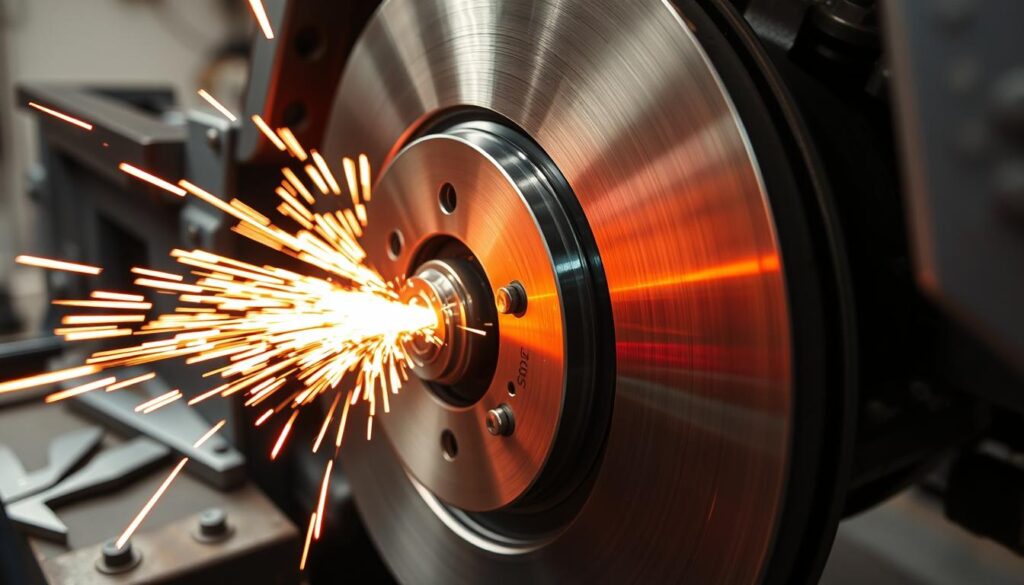
“Regular brake maintenance is one of the most important things you can do to keep your vehicle safe and reliable. Don’t skimp on this critical system.”
Brake Fluid Service and System Bleeding
Keeping your vehicle’s brake system in top shape is more than just checking the brake pads and rotors. It’s also about the brake fluid. This fluid is key for your brakes to work right.
It’s smart to get your brake fluid flushed regularly. This removes dirt and adds new fluid. Over time, brake fluid can get old and lose its effectiveness. Experts say to do this every 2-3 years or as your car’s manual suggests.
Bleeding the brake system is also important. It gets rid of air bubbles that can make the brakes less effective. Air in the fluid can weaken the brakes. Bleeding helps keep your brakes working well and keeps you safe on the road.
- Check your owner’s manual for the recommended brake fluid service intervals.
- Have a professional technician perform a complete brake system inspection, including a fluid flush and bleed, if necessary.
- Be vigilant for any warning signs, such as a spongy or low brake pedal, which may indicate the need for a brake system check-up.
“Maintaining the integrity of your brake fluid and system is crucial for your vehicle’s safety and performance.”
By focusing on brake fluid flushes and a bled brake system, you keep your brakes in great shape. This ensures a safe and confident drive. A well-kept brake system is vital for your car’s safety and life span.
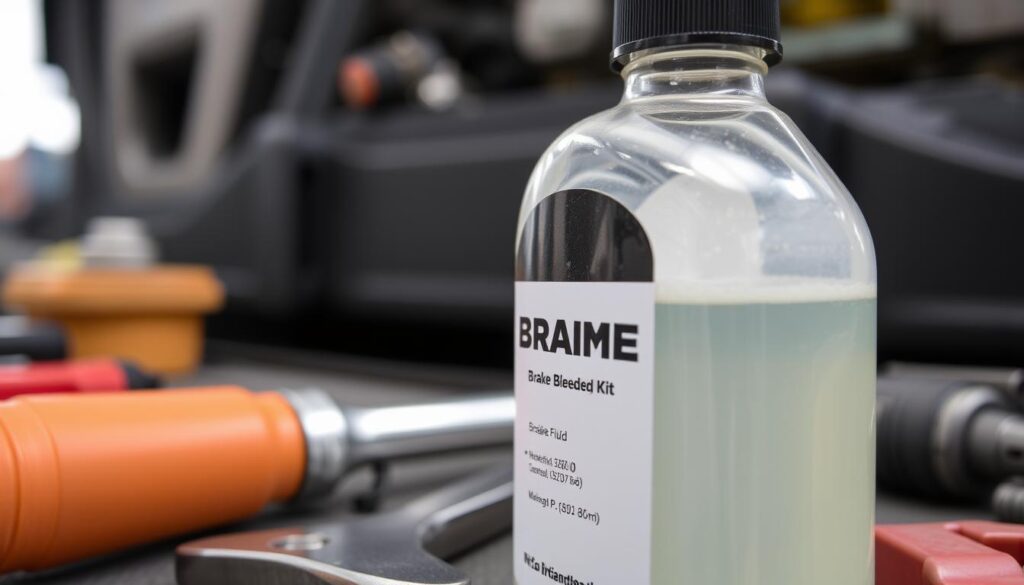
Proper Brake System Inspection Techniques
Keeping your vehicle’s brakes in good shape is key for your safety and your car’s life. Regular checks are vital to spot problems early and fix them before they get worse. Let’s look at how to inspect your brakes right and keep them working well.
Visual Inspection Steps
First, take a close look at your brake parts. Check the brake pads to see if they’re worn down too much. Look at the brake discs or drums for uneven wear, grooves, or cracks. Also, check the brake calipers for leaks or damage, and make sure the caliper slides move smoothly.
Testing Brake Performance
To check how well your brakes work, do a few tests. Press the brake pedal and see if it feels firm and quick to respond. If it feels soft or low, it might mean there’s a brake fluid issue or a leak. Also, test your brakes on the road to see how far you stop and if you hear any brake noise diagnosis.
Documentation and Maintenance Records
It’s important to keep good records of your brake checks and service history. Write down the date, mileage, and any brake repairs or findings. This helps you track your brake’s condition and spot any recurring problems. Regular brake system inspection and keeping records will help keep your brakes in great shape and help you plan for future maintenance.
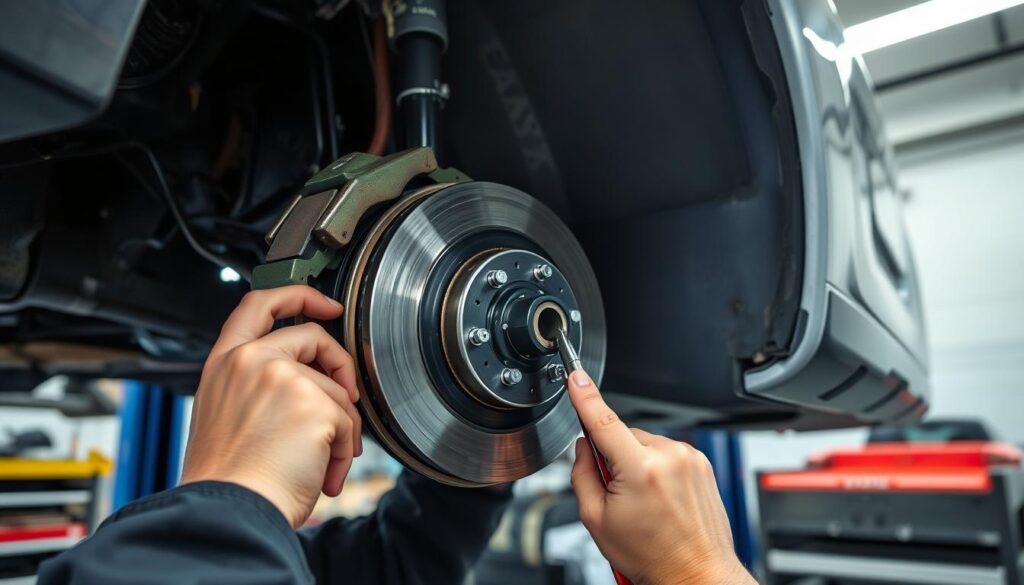
Remember, checking and maintaining your brakes properly is crucial for your safety and your car’s performance. By using these methods, you can catch problems early and fix them, making sure your brakes are always ready to help you when you need them.
Common Brake Problems and Troubleshooting
Your vehicle’s brake system is key to your safety on the road. Even well-maintained brakes can face issues. Knowing how to spot and fix common brake problems helps keep your vehicle safe and running well.
Brake Noise Diagnosis
Brake noise, like squeaking or squealing, is a common issue. It can mean worn brake pads or other problems. To find the cause, you need to check your brake system carefully.
Brake Caliper Overhaul
A malfunctioning brake caliper is another common problem. It can cause uneven wear or even brake failure. Look out for signs like uneven pad wear or a spongy brake pedal. If you think your caliper is failing, you might need a professional overhaul.
Fixing brake problems quickly is important for your safety and vehicle’s performance. Regular checks and maintenance can prevent bigger, more expensive issues later on.
| Brake Problem | Potential Causes | Troubleshooting Steps |
|---|---|---|
| Brake Noise |
|
|
| Brake Caliper Issues |
|
|
Understanding and fixing common brake problems keeps your vehicle safe and running smoothly. Regular maintenance and quick action to any issues are essential for keeping your brakes in good shape.
Professional Brake Service vs. DIY Maintenance
When it comes to brake maintenance, you have two choices. You can take your car to a professional or do it yourself. Each option has its own benefits and things to think about. Let’s look at what you need to consider to choose the right one for you.
Cost Comparison
Going to a professional for brake service might cost more at first. But, it usually includes detailed checks, high-quality parts, and skilled work. DIY brake work can save money if you have the right tools and know-how. But, remember to add up the cost of tools, parts, and your time.
Safety Considerations
Brakes are key to driving safely, and wrong maintenance can be dangerous. Pros have the training and tools to do the job right, keeping you safe. If you’re doing it yourself, make sure to follow safety rules and know what you’re doing.
Required Tools and Equipment
- Brake pad caliper tool
- Torque wrench
- Brake fluid tester
- Brake fluid
- Brake pad wear gauge
- Brake rotor micrometer
- Jack and jack stands
Trying DIY brake work without the right tools can be risky. It might lead to bad installation or adjustments. Make sure you have all the tools and follow the maker’s instructions to keep your brakes safe and working well.
Choosing between professional brake service and DIY depends on your skills, tools, and comfort with car repairs. Think about the cost, safety, and complexity of the job to decide what’s best for you.
Preventive Brake Maintenance Tips for Longevity
Keeping your vehicle’s brakes in top shape is more than just routine service. By following preventive maintenance tips, you can make your brakes last longer and stay safe on the road. Adjusting your parking brake regularly is key. It keeps it working right and prevents uneven wear on brake pads and rotors.
It’s also important to keep your brake parts clean. Cleaning your brake calipers, pads, and rotors regularly removes debris and slows down wear. Also, avoid harsh braking and frequent stops. Smooth braking helps your brake pads and rotors last longer.
By following these tips, you can keep your brakes in great shape for a long time. A well-maintained brake system makes driving safer and more efficient. With a bit of care, your brakes will perform well for many years.

